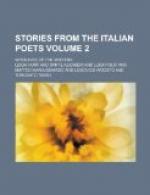So lived, and so died, and so desired humbly to be buried, one of the delights of the world.
His son Virginio had erected a chapel in the garden of the house built by his father, and he wished to have his body removed thither; but the monks would not allow it. The tomb, at first a very humble one, was subsequently altered and enriched several times; but remains, I believe, as rebuilt at the beginning of the century before last by his grand-nephew, Ludovico Ariosto, with a bust of the poet, and two statues representing Poetry and Glory.
Ariosto was tall and stout, with a dark complexion, bright black eyes, black and curling hair, aquiline nose, and shoulders broad but a little stooping. His aspect was thoughtful, and his gestures deliberate. Titian, besides painting his portrait, designed that which appeared in the woodcut of the author’s own third edition of his poem, which has been copied into Mr. Panizzi’s. It has all the look of truth of that great artist’s vital hand; but, though there is an expression of the, genial character of the mouth, notwithstanding the exuberance of beard, it does not suggest the sweetness observable in one of the medals of Ariosto, a wax impression of which is now before me; nor has the nose so much delicacy and grace.[28]
The poet’s temperament inclined him to melancholy, but his intercourse was always cheerful. One biographer says he was strong and healthy—another, that he was neither. In all probability he was naturally strong, but weakened by a life full of emotion. He talks of growing old at forty four, and of leaving been bald for some time.[29] He had a cough for many years before he died. His son says he cured it by drinking good old wine. Ariosto says that “vin fumoso” did not agree with him; but that might only mean wine of a heady sort. The chances, under such circumstances, were probably against wine of any kind; and Panizzi thinks the cough was never subdued. His physicians forbade him all sorts of stimulants with his food.[30]




